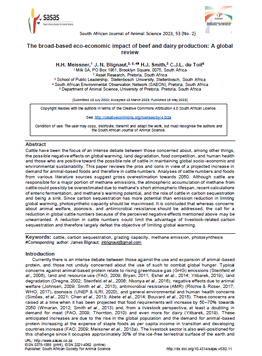 |
The broad-based eco-economic impact of beef and dairy production: A global review
H.H. Meissner, J. N. Blignaut, H.J. Smith, C.J.L. du Toit, 19 May 2023
Cattle have been the focus of an intense debate between those concerned about, among other things, the possible negative effects on global warming, land degradation, food competition, and human health and those who are positive toward the possible role of cattle in maintaining global socio-economic and environmental sustainability. This paper reviews the pros and cons in view of a projected increase in demand for animal-based foods and therefore in cattle numbers. Analyses of cattle numbers and foods from various literature sources suggest gross overestimation towards 2050. Although cattle are responsible for a major portion of methane emissions, the atmospheric accumulation of methane from cattle could possibly be overestimated due to methane’s short atmospheric lifespan, recent calculations of enteric fermentation, and methane’s warming potential, and the role of cattle in carbon sequestration and being a sink. Since carbon sequestration has more potential than emission reduction in limiting global warming, photosynthetic capacity should be maximised. It is concluded that whereas concerns about animal welfare, zoonosis, and antimicrobial resistance should be addressed, the call for a reduction in global cattle numbers because of the perceived negative effects mentioned above may be unwarranted. A reduction in cattle numbers could limit the advantage of livestock-related carbon sequestration and therefore largely defeat the objective of limiting global warming.
|